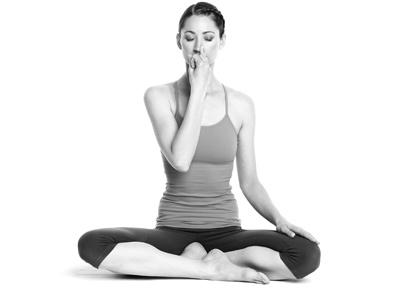Pranayama is generally defined as breath control. The word pranayam is comprised of two root words – ‘prana’ which means ‘vital energy’ or ‘life force’ and ‘ayama’ which means ‘extension or expansion’. Thus ‘pranayama’ means extension or expansion of the dimension of prana.
Pranayama utilizes breathing to influence the flow of prana in the energy channels or ‘nadis’. Therefore, pranayama should not be considered as mere breathing exercises aimed at introducing extra oxygen into the lungs.
“The techniques of pranayama provide the method whereby the life force can be activated and regulated in order to go beyond one’s normal boundaries or limitations and attain a higher state of vibratory energy and awareness.”
Practicing different Pranayama techniques establishes a healthy body by removing blockages in the body, enabling increased absorption and retention of prana or the life force.
Before we get started with the different Pranayama techniques and Pranayama benefits, let us lay down some general notes for the practitioner.
- Pranayama should not be practiced during illness, although simple breath awareness techniques and breathing in shavasana may be performed.
- The best time to practice pranayama is at dawn when the body is fresh and mind is free from all distractions. One can practice after sunset too, however try to practice pranayama regularly at the same time and same place each day.
- One should at least wash hands, face and feet before starting the practice and must wait for minimum half hour before bathing. This allows time for the body to cool down after the practice.
- Practice before eating in the morning or wait for 3-4 hours after meals before starting pranayama.
- Practice in a clean and calm environment free from clutter and mess. Ensure the room is well ventilated.
- Always breathe from the nose and not from the mouth unless otherwise specified in the techniques below.
- A practitioner must maintain a comfortable meditation posture to enable efficient breathing. The body should be relaxed with the spine, neck and head erect. Sit on a yoga mat or a folded blanket to ensure maximum conduction of energy during practice.
Now that we have listed the basic ground rules, let’s begin with the pranayama techniques and its benefits.
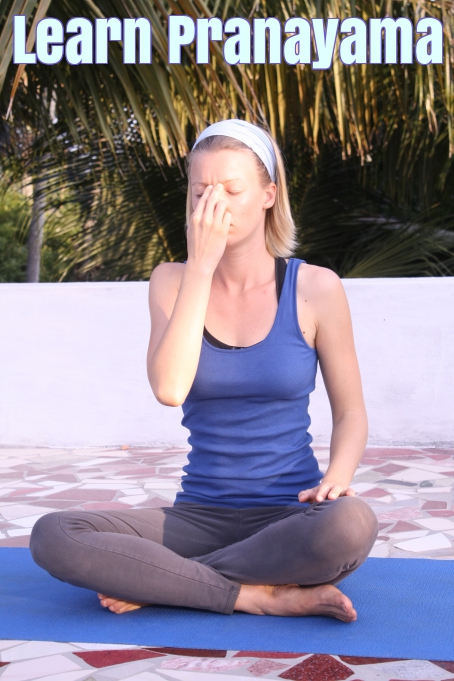
7 Pranayama Techniques and their Benefits | (How to?)
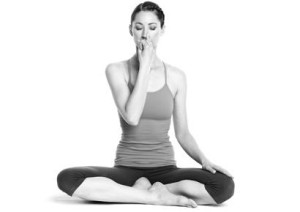
1. Nadi Shodhana Pranayama or Alternate nostril breathing technique:
‘Nadi’ means ‘channel or flow of energy’ and ‘shodhana’ means ‘purification. As the name suggests, Nadi Shodhana pranayama means that practice which purifies the nadis. This technique is also called Anulom vilom pranayama and has calming effects on the nervous system. It relieves anxiety, improves concentration and stimulates the third eye chakra or the ajna chakra. It is beneficial for people with respiratory problems such as asthama, emphysema and bronchitis.
How to do Nadi Shodhana Pranayama?
- Sit in any comfortable meditation posture
- Keep the head and spine upright, relax the whole body and close the eyes
- Practice few rounds of deep breathing (Yogic breathing) for sometime- deep inhalation followed by a slow, gentle exhalation. When the breath feels natural and relaxed you may begin the practice of nadi shodhana
- Place the tip of the index finger and middle finger of the right hand in between the eyebrows, the ring finger and little finger on the left nostril, and the thumb on the right nostril.
- Place your left hand on the left knee with the palm of the left hand open towards the sky.
- Close the right nostril with thumb of your right hand and inhale through the left nostril.
- Next, press the left nostril gently with the ring finger and little finger. Remove the right thumb from the right nostril and breathe out from the right.
- Inhale from the right nostril, close the right nostril and exhale from the left. This completes one round of Nadi Shodhana pranayama.
- Practice 5-10 rounds.
Also read : Pranayamas To Get Glowing Skin Naturally
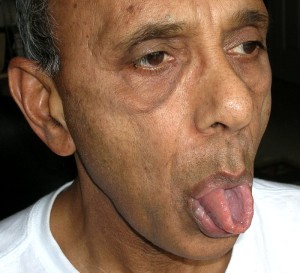
2. Sheetali Pranayama or cooling breath technique:
Sheetali pranayama is great to perform during summer or on a hot day as it instantly cools the body. It reduces mental and emotional excitation and encourages free flow of prana throughout the body. It relaxes the muscles and may be a good practice before sleep as it has calming effects on the mind.
(Note: Sheet means ‘cold’, Sheetal means ‘that which is calm, passionless and soothing’)
How to do Sheetali Pranayama?
- Sit in any comfortable meditation posture
- Close the eyes and relax the whole body
- Extend the tongue outside the mouth without any strain. Now roll the sides of the tongue so that it forms a tube.
- Take a deep breath in through the rolled tongue, draw the tongue in and close the mouth. Now exhale through the nose.
- This is one complete round. Practice 9-15 rounds. During summer up to 60 rounds can be performed.
People with low blood pressure or respiratory disorders such as asthama or bronchitis and excessive mucous should not practice this pranayama. Generally this should not be practiced during winter or cool climate. Since this practice cools down the activity of the lower energy centers, those suffering from chronic constipation should avoid it.
Must read : Pranayama to Reduce Hair Fall and Increase Hair Growth
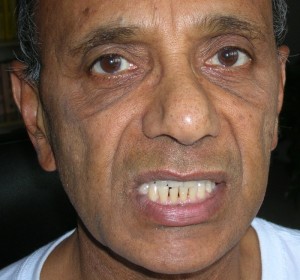
3. Sheetkari Pranayama or the hissing breath:
Sheethkari Pranayama has the same benefits as of Sheetali Pranayama as both these techniques are to cool the body during hot summer days. It relaxes the mind and calms the body too.
Practitioners with sensitive teeth or missing teeth should avoid this and practice sheetali pranayama instead.
How to do Sheetkari Pranayama or hissing breath?
- Sit in any comfortable meditation posture
- Close the eyes and relax the whole body
- Separate the lips exposing the teeth and hold the teeth lightly together as if giving a big smile to the world.
- Place the tongue flat in the mouth.
- Inhale slowly and deeply though the teeth. At the end of inhalation, close the mouth and exhale slowly through the nose in a controlled manner.
- This completes round one.
- Practice 9-15 rounds of this pranayama
Also read: 8 Yoga Poses to Improve Flexibility
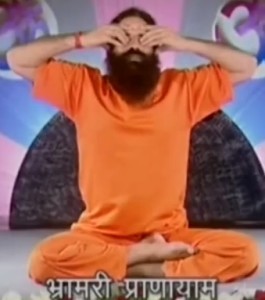
4. Bhramari Pranayama or the humming bee breath:
Bhramari Pranayama relieves stress and cerebral tension, thereby helps in alleviating anger, anxiety and insomnia. It strengthens and improves the voice and also induces a meditative state by harmonizing the mind and directing the awareness inward. The vibration of the humming sound creates a soothing effect on the mind and nervous system.
The best time to practice Bhramari Pranayam is early in the morning or late at night as surroundings are quieter and there is less interference with the internal perception. Practicing at this time awakens psychic sensitivity.
(Note: Bhramari means ‘bee’ and this practice is so called as a sounds in produced which imitates that of the black bee)
How to do Bhramari Pranayama?
- Sit in any comfortable meditation posture
- Close the eyes and relax the whole body
- The lips should remain gently closed with teeth slightly separated throughout the practice.
- Raise the arms sideways and bend the elbows, drawing hands to the ears. Using the middle or index finger, close the flaps of the ears.
- Bring the awareness to the center of the head where the third eye is located. Keep the body still and inhale though the nose.
- Exhale slowly and in a controlled manner; while making a deep, steady humming sound like that of a black bee.
- The humming should be continuous for the duration of the exhalation.
- This completes round 1. At the end of the round, the hands can be placed on the knee and then raised again for the next round.
- Complete 5-10 rounds of Bhramari Pranayama and slowly increase to 10-15 minutes of practice.
Must read : 7 Yoga Poses to Maintain a Good Posture
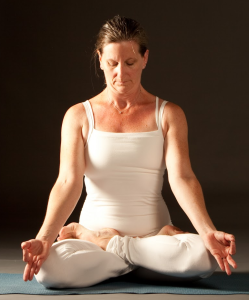
5. Ujjayi Pranayama or The psychic Breath
Ujjayi is classified as a tranquilizing pranayama. It also has a heating effect on the body. This psychic breathing technique soothes the nervous system and calms the mind. It has a very deep relaxing effect at the psychic level and also helps relives insomnia. It is beneficial for people with high blood pressure as it slows down the heart rate.
(Note: The Sanskrit word ujjayi means ‘victorious’. It is derived from the root ‘ji’ which means ‘to conquer’ and ud which means ‘bondage’. Therefor, Ujjayi Pranayama gives freedom from bondage)
How to do Ujjayi Pranayama?
- Sit in any comfortable meditation posture
- Close the eyes and relax the whole body
- Take the awareness to the breath in the nostrils and allow the breathing to become calm and rhythmic.
- Now transfer the awareness to the throat. Gentley contact the glottis and feel that breath is being drawn in and out through the throat and not through the nostrils.
- A soft snoring sound will be produced in the throat. If practiced correctly, there will be a contraction of the abdomen without any effort.
- The inhalation and exhalation should be long, deep and controlled.
- Begin with 10 breaths and slowly increase to 5 minutes for general benefits.
Also read : What is Hatha Yoga and Its Benefits?
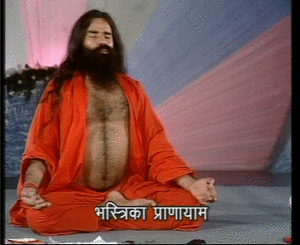
6. Bhastrika Pranayama or the Bellows Breath
Bhastrika Pranayama burns up toxins and helps balance doshas – which are the biological energies in our body. After a few months of proper preparation, this can be a useful practice for women during labour. Since this pranayama involves rapid exchange of air in the lungs, there is an increase in exchange or oxygen and carbon dioxide into and out of blood stream. This stimulates metabolic rate, producing heat while flushing out wastes and toxins.
It balances and strengthens the nervous system, inducing peace, tranquility and focus of mind in preparation of meditation.
(Note: Sanskrit work Bhastrika means ‘bellows’. Thus Bhastrika Pranayama is also known as Bellows Breath as air is drawn forcefully in and out of the lungs like the bellows of a village blacksmith)
How to do Bhastrika Pranayama?
- Sit in any comfortable meditation posture with hands on the knees in chin mudra
- Close the eyes and relax the whole body
- Take a deep breath in and breathe out forcefully through the nose.
- Immediately after the exhale, breath in with the same force.
- Continue in this manner for 10 breaths
- This completes round one.
- Practice upto 5 rounds.
- Forceful inhalation results from fully expanding the abdominal muscles and forceful exhalation results from firm contraction of the abdominal muscles. Although one should not strain.
- During inhalation, the diaphragm descends and the abdomen moves outward. Whereas, during exhalation, the diaphragm moves upward and the abdomen moves inward.
- The force of inhalation must be equal to force of exhalation.
Must read : 14 Yoga Asanas To Reduce Stress
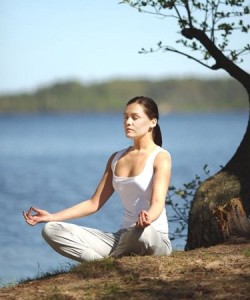
7. Kapalbhati Pranayama Or the frontal brain cleansing breath
Kapalbhati Pranayama has a cleansing effect on the lungs and is a good practice for respiratory disorders. It balances and strengthens the nervous system and tones the digestive organs. It also energizes the mind and makes it more active. This technique should not be practiced by those suffering from hearth related problems, high blood pressure, vertigo, epilepsy, stroke, hernia or gastric ulcer.
(Note: The sanskrit word ‘Kapal’ means ‘cranium’ or ‘forehead’ and ‘Bhati’ means ‘light’ or ‘knowledge’. Hence Kapalbhati is a practice which brings a state of light or clarity to the frontal region of the brain)
**There is a difference between Bhastrika Pranayama and Kapalbhati Pranayama. As mentioned above, while practicing Bhastrika Pranayama, there is a forceful inhalation and equal forceful exhalation. Here in Kapalbhati Pranayama, you will see that the exhalation is forceful whereas, the inhalation is relaxed and passive.
How to do Kalpalbhati Pranayama?
- Sit in any comfortable meditation posture with hands on the knees in chin mudra
- Close the eyes and relax the whole body
- Exhale through both the nostrils with a forceful contraction of the abdominal muscles.
- Inhale passively by allowing the abdominal muscles to relax
- After completing 10 rapid breaths continuously, take a deep inhale and exhale to relax.
- This completes round one. Practice upto 5 rounds
- Here, the inhalation should be spontaneous recoil, involving no effort.
Also read : 15 Powerful Yoga Asanas To Get Rid Of Belly Fat
With all the above Pranayama practices, it is important to remember not to strain and not to try and increase the capacity too fast. Before moving on the advanced techniques of breathing, one should get comfortable with the basic techniques explained above. Any retention of breath should not be practiced beyond one’s capacity. The lungs are delicate organs and any misuse can lead to injury.
Finally, not just the physical body, but also emotional and mental aspects of the body need time to adjust. Practice at your own pace to achieve maximum benefits of breathing. As always, enjoy breathing in and breathing out.
